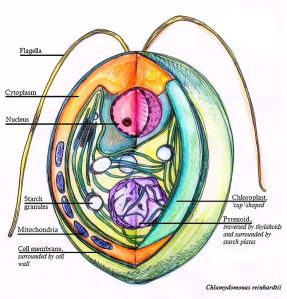It appears to be a universal experience for a scientist to find their experimental system beautiful. Perhaps this is because the daily discipline of examining anything in detail brings an appreciation of its finer points? Most, I think, simply delight in the beauty of nature. For some, this gives a sense of the transcendent: a sort of natural spirituality.
I’ve written about a number of Christians and their appreciation of beauty in their scientific work, but I also want to feature some others who don’t share those beliefs. Science is open to all comers, and that’s a good thing. Everyone can enjoy exploring the universe. In my browsings online I have found a biologist who has written beautifully on her own research, and I want to share the biology she loves with you*.
Lynne Quarmby is a cell biologist who’s passionate about explaining her work to people outside of the scientific community. She writes a regular column, a ‘nexus of mystery, art, literature, beauty and science’, for the online literary magazine Numéro Cinq.
…if we can recognize and acknowledge that our direct biological senses, as wonderful as they are, give us only a tightly pinched and cloudy view of the world, then we open ourselves to unimagined beauty.
Lynne Quarmby, Numero Cinq, 2011
Biologists often label themselves according to the model organism they work on. I was a zebrafish person, and Quarmby is a Chlamydomonas person. Chlamydomonas is not an STD (you’re thinking of Chlamydia), but a gentle single-celled algae that is in all likelihood swimming around the standing water in your garden as you read. This microscopic creature is easy to grow in the lab (a jam jar on a sunny windowsill will do), its genome has been sequenced, and it is a surprisingly powerful tool for studying human disease.
Chlamydomonas was not an obvious choice for medical research, but the secret is in the cilia. Cilia are hair-thin appendages that wave around in a coordinated fashion to move their owner from A to B. A dish of Chlamydomonas algae in motion looks like the beginners pool during a breaststroke lesson (scroll down to the second video). But these algae don’t spend their whole lives swimming around. When they reproduce, their cilia are absorbed back into the cell body (scroll down to the 4th video). When conditions are stressful, the cilia simply drop off. Quarmby and her students studied mutants that hold on to their cilia, and discovered a family of proteins involved in the regulation of both cilia and cell division.
At the same time as Quarmby was studying the behaviour of cilia in Chlamydomonas, medical researchers were identifying genes that are mutated in humans. The same proteins involved in cilia and cell cycle control in Chlamydomonas were affected in some patients with polycystic kidney disease. What’s the connection?
Cell biologists knew that most of our cells have cilia on them, but assumed that they were not important. Our cells generally do not swim around, unless they’re sperm. It turns out that these tiny appendages are involved in a whole range of vital cell functions. The cilia on kidney cells are important for sensing the flow of urine, and without these the kidney cannot function properly.
Perhaps beauty is in the eye of the beholder when it comes to unicellular flagellates, but what I appreciate is the detail. To see the minutiae of cell structure is stunning, particularly when you find out how difficult it is to achieve images like this (click on figure 3**). This microscopic pond dweller has advanced our understanding of a devastating human disease. The combination of aesthetic experience and elegant solution is what I find beautiful.
Quarmby’s lab continues to probe the biology of Chlamydomonas for interesting behaviours that will in all likelihood prove very useful for humankind.
*I should highlight that I haven’t contacted Lynn Quarmby, and she has not in any way endorsed this blog. ** Apologies to those not on a university campus who don’t have access to academic journals. References for the very keen: http://quarmby.ca/ http://blog.quarmby.ca/ http://www.ncbi.nlm.nih.gov/pubmed?term=Lynne%20Quarmby http://www.ciliopathyalliance.org/




